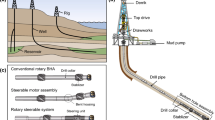Abstract
Deep hole drilling has been studied mainly experimentally in the past. Recently, some theories using beam or column equations have been proposed, which involved complicated mathematical efforts. This work analyzed deep hole drilling by a finite element model (FEM). Results of modal analysis on the established FEM were compared with results from Euler beam equations. Further analysis showed that the FEM could also predict straightness deviation as did the column equation. In addition, FEM could analyze the effects of variable support distance which neither beam nor column equation could. Other analysis results are also presented. The results in this study showed the strength and weakness of the FEM.
Similar content being viewed by others
References
Ramakrishna Rao PK, Shunmugam MS (1987) Accuracy and surface finish in BTA drilling. Int J Prod Res 25(1):31–44
Ramakrishna Rao PK, Shunmugam MS (1987) Analysis of axial and transverse profiles of holes obtained BTA machining. Int J Mach Tools Manuf 27(4):505–515
Furness RJ, Wu CL, Ulsoy AG (1996) Statistical analysis of the effects of feed, speed and wear on hole quality in drilling. J Manuf Sci E-T ASME 118:367–375
Chin JH, Wu JS, Young RS (1993) The computer simulation and experimental analysis of chip monitoring for hole drilling. J Eng Ind 115:184–192
Chin JH, Wu JS (1993) Mathematical models and experiment for chip signals of single-edge deep hole drilling. Int J Mach Tools Manuf 33(3):507–519
Griffiths BJ (1993) Modelling complex force system, part 1: the cutting and pad forces in deep drilling. J Eng Ind 115:169–176
Griffiths BJ, Grieve RJ (1993) Modelling complex force system, part 2: a decomposition of the pad forces in deep drilling. J Eng Ind 115:177–183
Chin JH, Lin SA (1996) Dynamic modelling and analysis of deep-hole drilling process. Int J Model Simul 16(3)
Chin JH, Lee LW (1995) A study on the tool eigen-properties of a BTA deep hole drill—theory and experiments. Int J Mach Tools Manuf 35(1):29–49
Chin JH, Hsieh CT, Lee LW (1996) The shaft behavior of BTA deep hole drilling tool. Int J Mech Sci 38(5):461–482
Perng YL, Chin JH (1999) Theoretical and experimental investigations on the spinning BTA deep-hole drill shafts containing fluids and subject to axial forces. Int J Mech Sci 41:1301–1322
Deng CS, Huang JC, Chin JH (2001) Effect of support misalignment in deep-hole drill shafts on hole straightness. Int J Mach Tools Manuf 41:1165–1188
Kakade NN, Chow JG (1993) Finite element analysis of engine bore distortions during boring operation. J Eng Ind 115:379–384
Nelson HD (1996) A finite rotating shaft element using Timoshenko beam theory. J Mech Design 102:793–803
ANSYS (1995) User’s guide for revision 5.3. Ansys, Inc., Canonburg, PA
Sakuma K, Taguchi K, Katsuki A (1981) Self-guiding action of deep-hole-drilling tools. CIRP Ann 30:311–315
Author information
Authors and Affiliations
Corresponding author
Rights and permissions
About this article
Cite this article
Chin, JH., Sheu, SD. Strengths and weaknesses of finite element modeling deep hole drilling as compared with beam and column equations. Int J Adv Manuf Technol 32, 229–237 (2007). https://doi.org/10.1007/s00170-005-0332-2
Received:
Accepted:
Published:
Issue Date:
DOI: https://doi.org/10.1007/s00170-005-0332-2




